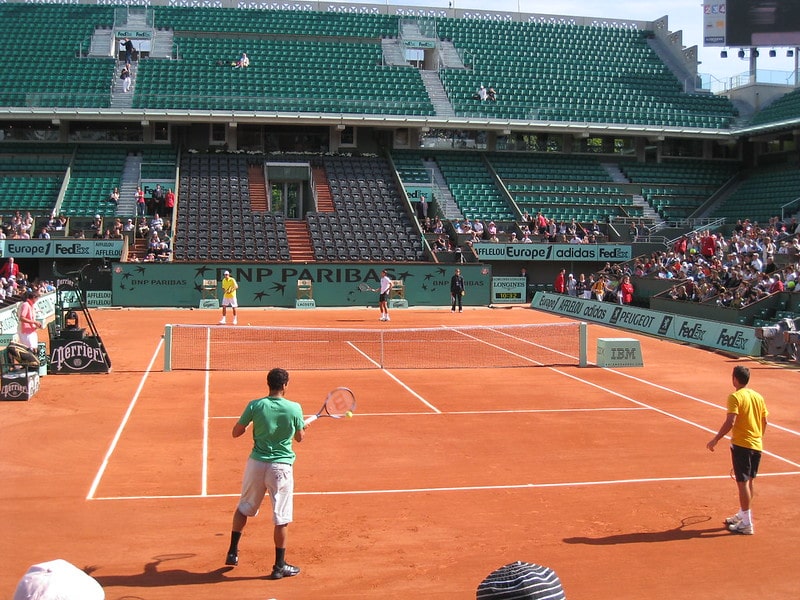Last updated on June 27th, 2023
Interesting facts about Tennis Courts
64. Tennis court is the venue where a tennis match is played.
65. In the beginning, tennis courts were hourglass-shaped. Rectangular courts have been in existence since 1875.
66. Different types of surfaces can be used to create a tennis court. E.g. Clay, grass, hard, and carpet. Each surface affects the playing style of the game. On some surfaces the ball moves fast while on the others it moves slowly.
67. The International Tennis Federation is the governing body of Tennis and looks after the rules of the game.
68. For singles matches, the tennis court is 78 feet (23.77 m) long and 27 feet (8.23 m) wide. For doubles matches, the length of the court remains the same but the width is 36 feet (10.97 m).

69. On each side of the court, the area between the service line and the net is divided into two equal parts, the service courts, by the centre serviceline. The centre serviceline is drawn parallel to the singles sidelines and half way between them.
70. The service lines are 21 feet from the net on each side.
71. The lines at the ends of the court are called baselines and the lines at the sides of the
court are called sidelines.
72. It is interesting to note here that all court measurements are made to the outside of the lines and all lines of the court shall be of the same colour clearly contrasting with the colour of the surface.
73. Some more clear space around the tennis court is needed for the players to reach overrun balls. Thus, an area of at least 60 feet in width and 120 feet in length is needed to build a comfortable tennis court.
74. The net which is placed at the centre of the court, parallel with the baselines, divides the court into two equal parts.
75. The net is 3 feet and 6 inches high at the post and 3 feet high at the centre.

76. Wimbledon is the only Grand Slam to have always been played on the same surface – grass. The rest of the three Grand Slams have switched their surfaces sometime or the other in the past.
77. The U.S. Open is the only major to have been played on three surfaces.
78. Grass court is the fastest type of the courts in common use. It tends to favor serve and volley tennis players. The serve plays an important role here because the ball bounces low on this surface and the points are short. Tournaments played on grass include Halle Open, the Stuttgart Open etc. Roger Federer is one of the greatest grass court players the game has ever seen. He has won a record of eight Wimbledon titles.

79. Clay court supports baseline players because the court surface allows higher bounce and hence the players get more time to get to the ball and return the shot. Players can also easily slide from side to side on the surface. Rafael Nadal is the world’s best clay court player. He has won 12 French Open Grand Slams.

80. The third type of court surface is the hard court. It is made from asphalt or concrete with a coating of paint on the top. The paint is mixed with some sand to control the speed of the ball on the surface. The size and the quantity of the sand mixed in the paint affects the speed of the ball on the court. The US Open uses an acrylic hard court and the Australian Open uses a synthetic hard court. Tournaments played on hard court include Nitto ATP Finals, The Shanghai Masters etc.

81. An advantage of the hard court is that it dries up very quickly and hence it is considered an all weather surface.
82. Rallies on the hard court are longer than the grass but generally shorter than on clay.
83. The fourth type of court surface is carpet. It is a removable court covering. The surface is made of turf and sand is spread on it. A carpet court is the second fastest court surface next to grass court. The balls on this surface do not bounce very high and hence do not give the player much reaction time to return it. However, these courts are in a very limited use today because the matches played on this surface are not much engaging to watch.
Some interesting tennis laws
- If an additional ball enters the court while a point is in progress, the point must be replayed.
- If a player catches the ball during a point before it bounces, they forfeit the point (regardless of the ball’s position). The ball must hit the ground first for the ball to be ruled out before a player can catch it or stop it with his body.
- The receiving team is allowed to stand anywhere during the serve except in the service box.
- If a doubles team audibly communicates loudly during a point, they forfeit the point.
- If the serving player swings during the toss and misses the ball, it is considered a fault.
